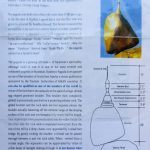Join in!
You can leave a comment on any of the items on this page, and read other visitors’ comments. Just click on the link at the bottom of any item which says “Leave a comment” or “X Comments”.
Rangoon/Yangon for the last time: you’re not going to believe this, but…
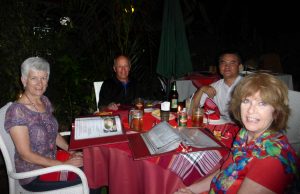 Because of a hiccup in the arrangements for the trip, the travel company kindly offered to give us a free dinner on our last night in Rangoon/Yangon. Accordingly, we were picked up at 6.45 this evening and whisked to the Padonmar Restaurant where we had a very enjoyable dinner in the garden. This is a picture of us all. L-R: Carol, me, our guide Aung and Sheila. You can see a larger view by clicking on the picture.
Because of a hiccup in the arrangements for the trip, the travel company kindly offered to give us a free dinner on our last night in Rangoon/Yangon. Accordingly, we were picked up at 6.45 this evening and whisked to the Padonmar Restaurant where we had a very enjoyable dinner in the garden. This is a picture of us all. L-R: Carol, me, our guide Aung and Sheila. You can see a larger view by clicking on the picture.
During dinner we talked about my grandparents’ house in Rangoon/Yangon and Aung asked a waiter where Kha-Yae-Bin Road was, to be told the restaurant is on that very road. When asked where number 111 was he replied that it was next door!
It turned out that we were having dinner in the “swanky restaurant” mentioned by my cousin Alexandra as being next to her best guess as to the house my grandparents lived in when he was Acting Chief Justice.
As it was dark I couldn’t get a photo of the house but I’m hoping we’ll have time for a quick visit before we leave for home tomorrow.
NOTE: Because of intermittent internet access and time pressures I haven’t been able to keep up with the trip as it happened. However I still have plenty to share and hope shortly to post items about Inle Lake, Bagan and the pagodas, the Taukkyan War Cemetary and more.
In the meantime, as I will be travelling back home very soon, I’ve now removed the password ontrol from the blog so you can see future updates without having to log in.
Kyalkhtiyo to Moulmein (Mawlamyine)
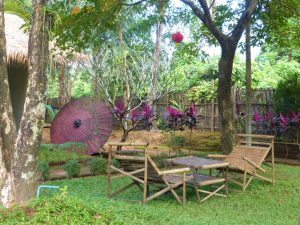 The Golden Sunrise Hotel in Kyalkhtiyo was only a waystop, but it was a pleasant hotel and good quality. Again we had cabins in the garden, which is always nice and gives a feeling of privacy which I enjoy. The garden was liberally enlivened by decoration such as Chinese lanterns and parasols, and a generally pleasant time was had by all.
The Golden Sunrise Hotel in Kyalkhtiyo was only a waystop, but it was a pleasant hotel and good quality. Again we had cabins in the garden, which is always nice and gives a feeling of privacy which I enjoy. The garden was liberally enlivened by decoration such as Chinese lanterns and parasols, and a generally pleasant time was had by all.
Burmese people are naturally friendly and open, always ready to smile and say hello – and these attributes make them naturals for the hospitality industry. We’ve been impressed time and time again by their attentiveness, readiness to help and smiling, happy disposition. It really is a pleasure to be looked after by them! I hope their burgeoning tourist industry doesn’t corrupt this lovely friendly nature, as has happened in so many countries.
We left at about 8.30 and drove straight on. Moulmein is some way from Rangoon/Yangon and indeed the leg from our hotel to Moulmein itself lasted until lunchtime. But part of the pleasure of travelling is that the everyday becomes fresh, and we saw a lot of interesting sights on the way. Our guide took us to a rubber plantation near the road, which was fascinating as ever. The interesting aspect of rubber production in Burma is that it’s a traditional craft as well as an exporting industry: their sandals have, historically, always had rubber soles in contrast to the leather that predominates in nearby countries. As well as catering for this market the plantation also exports to China – as indeed do many industries such as corn/cornmeal, bamboo and more. China is certainly a hungry neighbour.
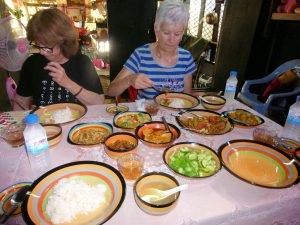 There was another very special lunch awaiting when we arrived in Moulmein, at the family home of one of the manageent of the ground agent company that’s organising our trip. Again there was a plethora of dishes, this time with an increased content of fish and the like – Moulmein is a sea-port, so naturally their diet leans in this direction.
There was another very special lunch awaiting when we arrived in Moulmein, at the family home of one of the manageent of the ground agent company that’s organising our trip. Again there was a plethora of dishes, this time with an increased content of fish and the like – Moulmein is a sea-port, so naturally their diet leans in this direction.
It wa a privilege to be entertained in a private home in this way, and meet so many of the family, from Grandma who cooked the meal to her daughters and grandson – who was atypically shy and lurked at the doorway with one eye watching us and the other well hidden behind the jamb.
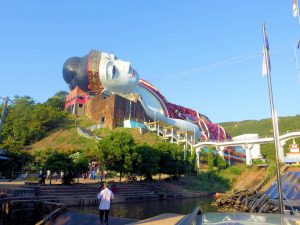 The high point of the day was after lunch when we visited Moulmein’s reclining Buddha, the largest in the world at 200 metres long. It was a stunning experience to see the huge statue, which has three storeys inside it, and feel the devotion and piety that must have inspired its creation.
The high point of the day was after lunch when we visited Moulmein’s reclining Buddha, the largest in the world at 200 metres long. It was a stunning experience to see the huge statue, which has three storeys inside it, and feel the devotion and piety that must have inspired its creation.Bang next door to it another reclining Buddha statue is being constructed, this time half as large again, at 300 metres. The two statues will lie facing one another across a small valley and together will make up an even more impressive site.
These sites are seldom restricted to the item that gives them their name, and Moulmein’s reclining Buddha is no exception. You approach the site along a road with 500 statues of monks along the side, and once you arrive there is a plethora of stupas, other Buddha statues, statues of monks and other notables, heraldic and ceemonial animals and so on. It’s a spectacular experience.
We finished with a quick visit to the riverfront at Moulmein, just missing the sunset but in time to see some lovely skies reaching over the river and town. It was truly a satisfying day.
Rangoon/Yangon to Kyalkhtiyo via Golden Rock Pagoda
24th November
After stopping for an excellent lunch in Lepya we drove on for about half an hour to visit the Golden Rock Pagoda. We parked at what the guide rather ominously started calling “base camp”. There we got onto a truck with seats to actually go up the hill. The rock itself is at an altitude of 1,100 metres and the road up to it is very windy and precipitous in places. The 40-50 passengers on board enjoyed this immensely, all joining in calls of “Who-o-o-ah!” and laughing hysterically.
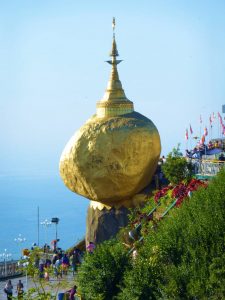 When we reached the top there was still a climb to go. We bravely forged on, joining monks, pilgrims and other devotees as well as porters carrying luggage (there are a couple of hotels at the summit) and some visitors in sedan chairs being borne aloft by four bearers. It was impressive to watch the routine used to remove sandals while keeping the passenger aloft at shoulder-height!
When we reached the top there was still a climb to go. We bravely forged on, joining monks, pilgrims and other devotees as well as porters carrying luggage (there are a couple of hotels at the summit) and some visitors in sedan chairs being borne aloft by four bearers. It was impressive to watch the routine used to remove sandals while keeping the passenger aloft at shoulder-height!
The rock itself is impressive, though I’m not sure I completely buy the legend about it being held in place by a single hair from buddha’s head. I’m currently working on an alternative explanation which I hope to share with you shortly.
The clear mountain air, crystalline evening light and surrounding ambience of devotion made this a fascinating and moving experience. Whole families were there, many making camp on the marble floor of the concourse preparing to stay the night – apparently the early morning is the most auspicious time to make an offering. There was a restrained and respectful carnival atmosphere which was quite remarkable and people were united in the purpose of their visit.
We decided not to stay to see the sunset over the rock as it would have meant taking the return bus in the darkness, and there was already some apprehension about the return trip, relying quite heavily as it would on the conditon of the truck, its brakes and the driver.
However all was well and we duly arrived at the Golden Sunrise Hotel in Kyalkhtiyo to spend the night before going on to Moulmein in the morning.
Burmese food: delicious – and not hot!
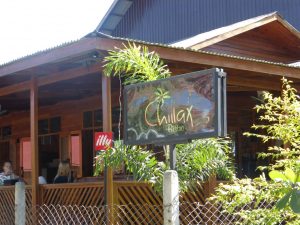 We’ve been getting closer to the actual food eaten by the Burmese people. When we first arrived we were very conscious of the Chinese influence, with stir-fries and noodles and dishes like chicken with cashew nuts. But as we’ve travelled ore into the country, especially into the Shan state area, we’ve been eating what I’m told is more genuine Burmese fare, and from my limited experience with recipes passed down, I’m sure that’s the case.
We’ve been getting closer to the actual food eaten by the Burmese people. When we first arrived we were very conscious of the Chinese influence, with stir-fries and noodles and dishes like chicken with cashew nuts. But as we’ve travelled ore into the country, especially into the Shan state area, we’ve been eating what I’m told is more genuine Burmese fare, and from my limited experience with recipes passed down, I’m sure that’s the case.
To my surprise Burmese curry appears not to be chilli hot. All the recipes I’ve had passed on to me, or read in good cookery books, do include varying amounts of chilli, so this is a bit mystifying.
However, other features are more familiar. A meal generally consists of a soup (which may include meat, tofu, vegetables and/or noodles) and two or three curries accompanied by a number of side dishes – salads, pickles, cooked vegetables, flavourings such as crispy onions or peanuts, and served of course with plenty of boiled rice. There are no taboos about the meat/fish eaten, so a meal might include beef, fish, chicken and/or pork as well as vegetarian curries.
Ngapi, or pickled preserved fish (see my post Thanaka, Longyis and Ngapi), is generally used as an ingredient and adds a distinctive but subtle flavour – salty and adding depth to the meat. In one dish, however, mohinga, it is a main element, giving this soup/noodle dish a strong “dead fish” taste which I found quite unpleasant. I might give it one more try, however – it’s a ubiquitous dish and the main constituent of many Burmese people’s diets, so I should get to know it.
Another common ingredient is tamarind. This imparts a lively, tangy taste and can be added to soups, fish and salads. I had a delicious tamarind sorbet at the improbably-named Chillax Bistro which was a splendid counterbalance to the main course.
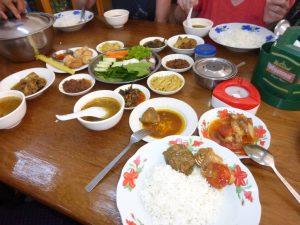 On the way from Rangoon/Yangon to the Golden Rock we stopped for lunch in a village called Lepya where there is a village restaurant. It seemed as a if the whole village were there, a great cacophony of noise and delicious smells. You chose your curry or curries at a counter – I chose a prawn dish in a spicy sauce and a chicken curry – and they brought it to the table with a vast array of side dishes – soup, rice plus a salad plate with lettuce, cucumber, tomato, baby aubergines, carrot sticks,white cabbage, spting rolls and the most delicious lemon leaves – like eating lemon grass without the chewy bits and amazingly refreshing. Then there was an assortment of accompaniments including ngapi with chilli, bamboo leaves, bamboo shoots and roselle leaf (sour and tangy). It was a great feast, served and consumed with great gusto, much shouting, clattering and laughter. A real treat – and only 4,500 kyats each – less than £5!
On the way from Rangoon/Yangon to the Golden Rock we stopped for lunch in a village called Lepya where there is a village restaurant. It seemed as a if the whole village were there, a great cacophony of noise and delicious smells. You chose your curry or curries at a counter – I chose a prawn dish in a spicy sauce and a chicken curry – and they brought it to the table with a vast array of side dishes – soup, rice plus a salad plate with lettuce, cucumber, tomato, baby aubergines, carrot sticks,white cabbage, spting rolls and the most delicious lemon leaves – like eating lemon grass without the chewy bits and amazingly refreshing. Then there was an assortment of accompaniments including ngapi with chilli, bamboo leaves, bamboo shoots and roselle leaf (sour and tangy). It was a great feast, served and consumed with great gusto, much shouting, clattering and laughter. A real treat – and only 4,500 kyats each – less than £5!
Mandalay photo gallery at last!
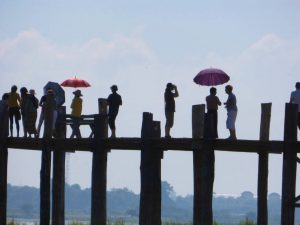 I’ve finally managed to beat the blog into submission and uploaded a number of photos – and two videos – of our time in Mandalay. I hope to annotate them and/or write another piece soon, but time is pressing and it looks like being difficult to get good internet access from now until we return to Rangoon/Yangon on Sunday 27th. I will of course do what I can, but a combination of a busy timetable and sketchy wifi availability may make it difficult.
I’ve finally managed to beat the blog into submission and uploaded a number of photos – and two videos – of our time in Mandalay. I hope to annotate them and/or write another piece soon, but time is pressing and it looks like being difficult to get good internet access from now until we return to Rangoon/Yangon on Sunday 27th. I will of course do what I can, but a combination of a busy timetable and sketchy wifi availability may make it difficult.
We were in Mandalay on Thursday 17th November.
To view the gallery click here.
My Grandparents’ House
I’ve skipped a couple of days, which I will catch up in due course, as I wanted to write about my visit to the summer house in Kalaw while it’s still completely fresh. In many ways it’s become the focus of the whole trip.
To recap briefly, my grandfather had this house built as a summer house to escape the heat of the summer. When the Japanese invaded Burma during the war they had to flee the country (to Bangalore, in India) and managed to sell the house to the sawbah (local Shan prince) in 1949.
Fast forward to 2008 and a local hotel group purchased and refurbished the house, turning it into a Royal Kalaw Hills Resort with cabins/villas in the garden. The original building still exists, of course, and contains four top-quality bedrooms as well as various living rooms, all tastefully redecorated. The house has come back to life.
We (Sheila, Carol and I) arrived there mid-afternoon after a mostly uneventual flight from Pagan/Bagan followed by an efficient 1½-hour car journey to the hotel.
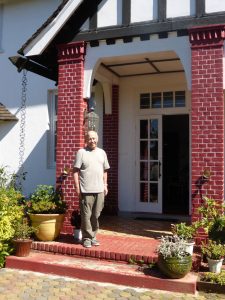 It’s difficult to describe my emotions as I got out of the car. Part of me was saying it was just another hotel, although with a special historical and personal connection; but as I approached the place, and thought of my grandparents, both of whom died the year I was born, and my mother, who may have spent time here as a child, along with her brothers and sisters, I did feel a strong association with the place and shed a tear in their memory.
It’s difficult to describe my emotions as I got out of the car. Part of me was saying it was just another hotel, although with a special historical and personal connection; but as I approached the place, and thought of my grandparents, both of whom died the year I was born, and my mother, who may have spent time here as a child, along with her brothers and sisters, I did feel a strong association with the place and shed a tear in their memory.
I must have bored or (hopefully) intrigued many members of staff, and our guide, with my photographs of my grandparents and the story of the house. It was surprisingly difficult not to tell everybody I met about it.
They treated us to a guided tour of the old house, and thanks to the sensitive restoration I could envisage my grandparents and their children (8 at the maximum) having happy times there. You can see the photographs I took in the Kalaw House gallery.
Interestingly, our guide told me that the family house in Rangoon/Yangon, at Kha Ye Bin Road, has also been converted into an up-market hotel, called The Governor’s Residence. I hope to investigate further when I’m back in Rangoon/Yangon. Apparently it’s a seriously top-of-the-range hotel. For our guide in Kalaw to know about it, some 370-odd miles away, it must be well-known.
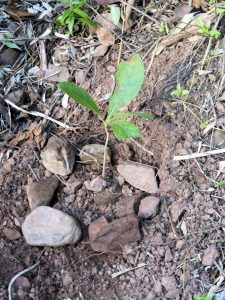 Later in the day we visited an elephant sanctuary for retired working elephants, of which more later. While there I planted a teak tree in memory of all my family and those with connections to Burma in partiicular. I hope it will grow and flourish for many years as an active and living memorial to my journey here.
Later in the day we visited an elephant sanctuary for retired working elephants, of which more later. While there I planted a teak tree in memory of all my family and those with connections to Burma in partiicular. I hope it will grow and flourish for many years as an active and living memorial to my journey here.
Of course, it has long been an ambition of mine to visit Burma, and this house in particular. For my family members it has strong associations, and it certainly is an excellent building with much history in its stones.
At times I felt a bit as if I were “building up the part”, having had no special association with the Burmese side of the family my grandparents left behind when they fled.
But there is no denying that there is a special link, be it fanciful or concrete; and I’m left with a strong feeling that somehow, something of personal significance took place today.
Mandalay and Bagan
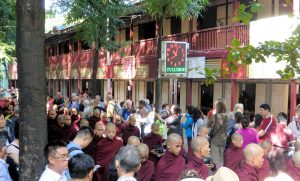 We had a wonderful three days in Mandalay and Bagan – so much to write about! Therefore, of course, I’m falling behind.
We had a wonderful three days in Mandalay and Bagan – so much to write about! Therefore, of course, I’m falling behind.
So I’m concentrating on photos rather than writing, partly because it requires less mental effort, partly because it’s worth a thousand words. Also becuse tomorrow, 21st November, is the day I reach the house my grandfather built in Kalaw, which will be a pivotal moment in the journey and which I really want to concentrate on. So I might end up writing more about that day than the previous three, even though the latter have been worthy of detailed documentation, which will arrive in due course.
In the meantime, you might enjoy seeing some of the photos I took in Mandalay, which was completely different to the whole trip so far. You can see them here, in an album that will be added to – so come back soon.
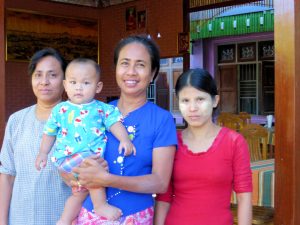 Bagan (or Pagan, as I always knew it) has been wonderful. We hired bikes and rode around pagoda-spotting, and getting closer in touch with local people and their lives. We visited a lacquer shop for some retail therapy, saw long-necked women from upstate Shan weaving beautiful scarves, and had a superb Burmese meal (at last!) at Ma Ma Moe’s restaurant and felt as if we’d made friends with all the family.
Bagan (or Pagan, as I always knew it) has been wonderful. We hired bikes and rode around pagoda-spotting, and getting closer in touch with local people and their lives. We visited a lacquer shop for some retail therapy, saw long-necked women from upstate Shan weaving beautiful scarves, and had a superb Burmese meal (at last!) at Ma Ma Moe’s restaurant and felt as if we’d made friends with all the family.
As they say (or used to) on Fleet Street, More follows…
Kyaukme to Mandalay via Pyin Oo Lin and Gokteik Viaduct
16th November
Another travel day, varied and eventful.
We had been advised to consider buying some food and a cushion for the train ride to Pyin Oo Lin, so we popped out after breakfast for a little shopping. Happened across the local indoor market and spent some time there browsing and looking at the merchandise.
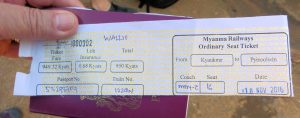 Then to the railway station. General hubbub of activity, and anxious moments waiting to see where our carriage was, whether there was a goods van – you know the sort of stuff. But in the event there was no need to worry – the train stopped at the station for 5-10 minutes and everyboody was most helpful.
Then to the railway station. General hubbub of activity, and anxious moments waiting to see where our carriage was, whether there was a goods van – you know the sort of stuff. But in the event there was no need to worry – the train stopped at the station for 5-10 minutes and everyboody was most helpful.
A frisson was caused by the observation that the price of the ticket included an element for life insurance!
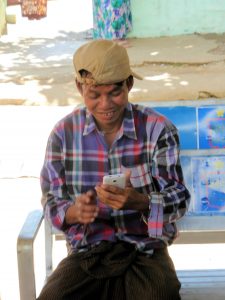 A lovely porter helped us get the luggage on board and then helped us to find our seats and stow the bags away safely. Then he returned to the platform and produced an ancient iPhone with which he took our photos, and all other tourists, through the open windows. We left him viewing the pictures and looking absolutely delighted with himself.
A lovely porter helped us get the luggage on board and then helped us to find our seats and stow the bags away safely. Then he returned to the platform and produced an ancient iPhone with which he took our photos, and all other tourists, through the open windows. We left him viewing the pictures and looking absolutely delighted with himself.
As the train came in I had noticed there were two classes: upper class and ordinary. Looking into the carriages (all the windows were open, so this was easier than you might expect) the only discernable difference I could see between the accommodation was that in the upper class the un-upholstered, brown-painted benches were adorned with a piece of white cloth resembling an anti-macassar, so I was not particularly disappointed to discover our seats were in ordinary class.
In fact it turned out to be a bonus, as our fellow travellers were about 60% Burmese, rather than European/western. The two-hour trip gave me plenty of time to practise my Burmese – “Mingalar-bar” for hello, “Chies-iu” for thank you. That’s it at the moment, so conversation was a little restricted. But plenty of hand gestures and lots of smiles and we got along just fine. [In fact I have discovered a third phrase, which in my experience is understood all over the world: “Manchester United”.]
We also managed to ask some fellow passengers to tell us when we were approaching our destination, which was a good thing because the train made several apparently unscheduled stops, sometimes in a village with no station, once absolutely in the middle of nowhere, apparently to let one man off. So counting stops would have been counterproductive!
The most fascinating part of the journey was, of course, the people. Not only were food and drink sold on the platform, the vendors also came on board and travelled with us for a time whilst selling their wares. I was seriously tempted by a huge bowl of noodles, chickens and vegetables, with a delicious-smelling source and garnished with coriander, chives and chopped chilli, but my recent experience of digestive problems has unfortunately compelled me to be extra-cautious. So I had to be satisfied with the smell, a couple of photographs and a lavish description from a German couple who didn’t feel as inhibited as I about risking it. Of course, though they described it brilliantly and with great relish, that made me miss it even more!
T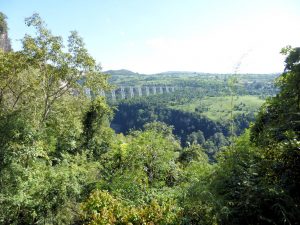 he high point of the journey was crossing the spectacular Gokteik Viaduct, a single-track affair built by the Pennsylvania Steel Company in 1901 at the request of the British government.
he high point of the journey was crossing the spectacular Gokteik Viaduct, a single-track affair built by the Pennsylvania Steel Company in 1901 at the request of the British government.
The viaduct is 102 metres high and 689 metres long, and an apparently very flimsy structure, which makes for an interesting ride. At the towers the bridge widens, presumably to give maintenance teams space to work and store stuff. There you can see down through the floor boarding, which suddenly gave me a sense of the height we were at, followed rapidly by a shock of vertigo. At another point we could see another railway line on the floor of the valley/ravine, which again brought it all home and made me a bit dizzy for a moment. Fortunately for me, I wasn’t affected as much as a woman in the next carriage, who at one point had an attack of the literally screaming abdabs!
The crossing took place at a slow walking pace, which gave you the feeling of gliding over the crevasse in an airship, particularly because from a seat by the window you can’t see vertically downwards enough to see any of the structure that’s supporting you. I’d love to have had a camera drone with me to take some shots from above and to the side of the train. Flying it safely back into the railway carriage through the window would be a challenge, though!
Eventually we arrived at Pyin Oo Lin station where we got off the tain, to the accompaniment of many calls of support from the Burmese contingent in the carriage, who by this time all knew we needed to be told when to disembark!
There followed a pretty nightmarish “private car” ride to Mandalay, in an un-airconditioned car without functioning seatbelts and a beep that reminded us that they were not functioning correctly every 30 seconds. As we approached Mandalay the scen became morerecognisable as a south-east Asian location, with increasing frequency of motorbikes, much more noise and bustle, and a general sense of energy and hustle that will be familiar to anybody who’s been to the region.
The driver was pretty uncommitted, stopping twice on the way out of Pyin Oo Lin to deliver packages, then asking if he could chel betel, then trying to persuade us to stop at a cake stall, before we lost patience and insisted he just get on with the job. When we got to Mandalay it becameclear he didn’t know the ocationof the hote, but eventually he found it by asking locals, only to discover that he had missed the turning and driving the wrong way along a dual carriageway to get us to our destinaton.
But when we finally arrived – bliss! We were greeted with cold scented towels and a glass of a refreshing chilled drink mmade of capsicums, green chilli, lime juice and pineapple juice that melted your heart and cooled your body. There was even a lift [US cousins: elevator] and a porter [US cousins: bellhop] to take our luggage to our rooms, which was particularly welcome for me, whose giant phlegm-coloured suitcase has been nicknamed “the green giant” by certain fellow travellers in our group.
So ultimately a happy ending to an energetic day, and off to bed after a great meal on the roof terrace with dreams of an exciting explore tomorrow.
Have a look at some photos of the day: Click here
Hsipaw to Kyaukme (“Chowkmay”)
15th November
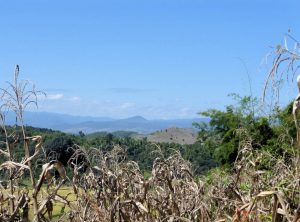 After the excellent day yesterday we had a bit of a challenge today. We transferred to Kyaukme, which is a little town in the foothills of the mountains. Being old and frail, we had arranged to go on a taxi trip around the local area and visit a hill tribe or two. unfortunately this message hadn’t got through to the people on the ground, and instead we found ourselves on an 11-kilometer trek up a “hill” and back down again. The whole excusion started at 9am and ended when we crawled back into our hotel at 4.30pm.
After the excellent day yesterday we had a bit of a challenge today. We transferred to Kyaukme, which is a little town in the foothills of the mountains. Being old and frail, we had arranged to go on a taxi trip around the local area and visit a hill tribe or two. unfortunately this message hadn’t got through to the people on the ground, and instead we found ourselves on an 11-kilometer trek up a “hill” and back down again. The whole excusion started at 9am and ended when we crawled back into our hotel at 4.30pm.
As we had realised when we were planning the trip, a trek like that, hard work at the best of times, would be pretty challenging in temperatures of up to 30°C and following straight on from the 4-hour walk the day before. It wasn’t helped by the fact that the last 30 minutes or so were down a near-vertical track in wet clay, very treacherous and alarmingly steep.
There were some good bits, nontheless. The day started with a local bus ride, which was certainly a bit of an adventure. An old an spontaneously started giving a German tourist a massage on the bus, which must have been wonderful after an hour or so of bumpy driving. The bus was, as usual, pretty crowded – though like many other aspects of the ccountry, not by any means as extreme or chaotic as, say, India can be.
Once on the trek we visited a village school and saw lots of cute kids, and had lunch in the house of a Palaung family which was interesting – they’re quite distinct from the rest of the state’s population,, with a different look and their own language.
Unfortunately got back too late to get to a Shan restaurant, so ate Chinese again. Still nice, though.
Hsipaw
14th November
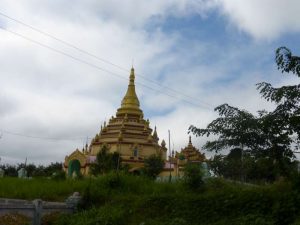 We had a great day in Hsipaw today. We went on a 4-hour walk through the valley, around the local villages and visited a monastery. It was the full moon – a super-moon this month, apparently – and all the villagers were getting ready for festivals to celebrate. Several times we were invited to join them, which would have been great fun but unfortunately not possible for time reasons.
We had a great day in Hsipaw today. We went on a 4-hour walk through the valley, around the local villages and visited a monastery. It was the full moon – a super-moon this month, apparently – and all the villagers were getting ready for festivals to celebrate. Several times we were invited to join them, which would have been great fun but unfortunately not possible for time reasons.
The people are very friendly – always ready with a smile and a wave, no sense of resentment or envy as is the case in some countries – and no demands for money. I quickly learned not to wave to people riding motor-bikes – they find it impossible to resist waving back, with potentially disastrous concequences!
In the evening we went off in a tuc-tuc to Sunset Pagoda to see the sunset. It was lovely, though because we’re near the equator you had to be ready for the actual moment – the sun seemed to sink below the horizon in a minute or less. There was a number of locals there, some praying, some courting, some just having a bit of an outing. It was all great fun, in spite of a certain amount of trepidation about the imminent journey down the hill and back to the hotel – personally, I found the prospect of something going wrong on the way down more daunting than on the way up! Needless to say, everything went well and we got back fine. Had dinner in a local Chinese restaurant called Mr. Food, which was delicious. There’s quite a strong Chinese influence here, strongest in the Shan states – which of course are nearest China anyway.
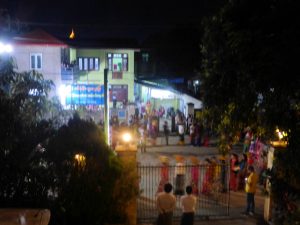 As an added surprise, as we got back to our hotel after dinner, there was a crowd of young girls, and a few boys, gathering in the street. We stopped tosee what was going on and then some music started and they all began dancing in a big circle. Lots of noise and rhythm, hand waving (so graceful!), bowing and laughing. It was a local private school across the street from the hotel, putting on a display for the full moon. Great fun, and lovely costumes.
As an added surprise, as we got back to our hotel after dinner, there was a crowd of young girls, and a few boys, gathering in the street. We stopped tosee what was going on and then some music started and they all began dancing in a big circle. Lots of noise and rhythm, hand waving (so graceful!), bowing and laughing. It was a local private school across the street from the hotel, putting on a display for the full moon. Great fun, and lovely costumes.
I took loads of photos, of course. You’ll find the photo gallery here.
Travel Day Rangoon to Hsipaw (say “See-Paw”)
13th November
A frustrating day, taken up almost completely with travelling. Not without its moments of anxiety/concern over the workings of travel arrangements!
The journey to the airport was a lot better than when we arrived. The traffic was light (maybe because it was a Sunday) and we drove along some interesting roads, still observing the faded grandeur of sweeping boulevards and decaying colonial buildings. The general rule appears to be that if a building is in good repair it belongs to the army, though we were again assured that the new government is making changes, with free education and health provision being introduced, though of course necessarily at a somewhat slow pace.
We had time to stop for a quick photo at the gates of the house where Aung Sang Suu Kyi was held under house arrest. Naturally not much to see, being still hidden behind imposing steel gates, though in due course it will no doubt become something of a shrine. Interestingly, the house is only a few hundred yards from the US embassy.
The airport was a reminder of how third world airports used to be (and often still are). There were no mechanical aids for baggage handling, so almost the first thing that happened when we entered the departure area was that our bags were whisked away and weighed on a huge red Avery weighing machine and we were led to the check-in desk, leaving the luggage sitting in an undignified pile on the floor. Once checked in, baggage tags were magically attached to the correct bags and they vanished on the shoulders of the first of a succession of incredibly slight and fragile-looking porters with the build of children. My case, embarrassingly the heaviest of the lot, actually seemed larger and heavier than the man carrying it!
There were regular and strident announcements of impending departures – at least that was what we assumed them to be, though in common with travel announcements all over the world, these consisted of “Attention please, ladies and gentlemen” followed by completely unintelligible speech, rounded off with “…immediately.” The system was assisted to an extent, however, by a succession of men carrying old-fashioned paging boards with “Flight… now boarding”, which ended up being the most reliable source of information, especially when a computer collapse, followed by an almost complete power blackout, rendered all other channels ineffective.
All the time the temperature and humidity both remained high, so we were in a seething mass of people being slowly rasted at 30˚C and 98% humidity. People, however, remained good-humoured and mutually supportive, and some rueful jokes and gestures were exchanged to keep the atmosphere relatively buoyant. I did, however, become a little weary of hearing repeated variations of the “Delay one hour” mantra.
The plane finally left several hours late, but at least we were on our way and in an air-conditioned environment. There was a moment’s concern as the (prop job) plane landed at the “wrong airport”, finding ourselves at Heho instead of Lashio, though for a short while we feared it was in fact Mandalay; but it transpired it was an interim stop which nobody had told us about and we stayed on the plane for the second leg.
On arrival at Lashio our bags were removed manually from the belly of the plane and left on the tarmac for a bit while the passengers all milled about taking selfies in front of the plane and wondering if we were meant to carry them ourselves. All was resolved when we were herded into the arrivals building and our passports were scrutinised and their details noted. There then followed a five-minute walk (without our bags) off the airport to a kind of concrete shelter where our bags were passed to us over a low wall and then taken to the car. Not quite sure of the thinking behind this ritual, but it seemed to appease some sort of concern amongst the Burmese travellers…
There followed a 2-hour journey in a minibus to our hotel in Lashio. Unfortunately, because of the flight delay, there was no time left “at leisure”, so we ate at the hotel (a bit of a mistake as it turned out) and went to bed, ready for the rigours of the next day.
Heathrow to Rangoon
I’ve added a photo gallery of some of today’s pictures. Click here to view them.
My phone tells me that it is now 14.33 on Saturday 12th November, so I rather have to believe it, though otherwise I haven’t got much by way of objective verification of the fact. I do know that it’s dark here in Rangoon and we’ve just returned to the hotel after supper, so as far as I am concerned I tend to rely more on my wristwatch, which is showing a time of five past nine, I think in the evening.
Travelling 7,000-odd miles Eastwards in 24 hours, landing first in a time zone 6 hours ahead and then on a connecting short flight Westwards but arriving in a time zone 6½ hours ahead is enough to confuse anybody, I imagine – it certainly worked for me. Total confusion about when to take the malaria tablets, what kind of meal we’re having (breakfast, lunch, dinner or somewhere in between) and more.
But we’re here in Yangon/Rangoon, safely ensconced in the hotel and properly fed, so in a way the finer details about what day and time it is are of less importance.
The journey started at 6am on Friday in Maidenhead, as I’ve already described. It was an early start the day, but we’ll worth it. The journey to the airport was excellent, with no rush-hour delays, and we got there in good time. Everything continued to go smoothly at the airport, where there was a surprise in store: I was mooching about the departure area when I suddenly saw a face I recognised! It was Malcolm Beer, a good friend from Ripon, and his wife Joan, who were travelling to Mandalay with a couple of friends for a river cruise down the Irrawaddy. They were even on the same flight – I did enjoy being able to say “see you in Bangkok”! A further coincidence was that we had met their friends before, when all four of them came to our house in Ripon for a Burmese meal Annabel and I cooked in support of the Cathedral!
Then followed a 12-hour flight to Bangkok in a giant two-decker aircraft called an A-380 or something. Got talking to two Burmese ladies (sisters) sitting next to me. They left the country in the late 80s because of the political situation and have been in the UK since. One of them has a daughter who’s a nurse in the UK and has never been to Burma, so they’re taking her back now the situation is improving, to show her the country. The daughter is following on in a day or two with her father when her nursing shift ends in London. Another emotional journey!
Two feature films, a complete 13-part TV series (dozed through), something which I felt was probably dinner and something else that definitely felt like breakfast and we arrived in Bangkok. Then a walk of epic proportions, which was regularly described on signs as “12 more minutes”, and we found the connecting flight, from Bangkok to Rangoon. And behold! Another breakfast (I think by then it was 8.30am local time) of Thai green curry and rice followed by chocolate cake, and we were finally landing in the capital of the country.
Airport arrival – much as usual, queue-hopping, visa stamping, luggage collecting (all present and correct, thankfully) and greeter meeting, which worked OK after a slightly worrying quarter of an hour where our names were nowhere to be found in the melée of signs, arms and calls that greeted us as we came through customs.
I didn’t take any photos on the way in from the airport – we’ll be doing the same trip in reverse tomorrow morning for our first domestic flight, and by now we were knackered. There was a huge amount of traffic, all cars, mainly 2 years old or less. Intriguingly they drive right-hand drive cars like we do, but drive on the right. It turns out that two years ago the new government lifted the restrictions on car ownership, meaning that, just like virtually anywhere else in the world, anybody with the money can buy a car. The commonest source is recent second-hand cars from Japan, purchased online, and hence this contradictory arrangement (Japan drives on the left, of course.)
There are still restrictions on motorbikes, which are generally used exclusively by the police and army, and not a tuc-tuc in sight for some reason, so the roads are struggling to cope with a huge influx of cars. ’Twas ever thus!
It turned out that we arrived at the hotel – a cute little boutique-ish hotel near the Sule pagoda (pronounced Soo-lay) at about 11.30am, and were picked up by our greeter/guide for Rangoon, a lady called either Rosa or Ai-Ai (as I the Automobile Association) according to whether you were us or the other person on the trip (there are just three of us), for a walking tour of central Rangoon. In the 30s, and humid, so sweat flowed freely. Still no sleep…
Central Rangoon is a fascinating blend of decaying British colonial buildings and some modern office blocks. Since the old government decided to build an entirely new capital city called Naypyidaw from scratch, they’ve been steadily moving government offices there from Rangoon, leaving a host of deserted, empty, once elegant buildings which nobody can find tenants for. There is scarcely a building in central Rangoon that hasn’t got at least one sapling sprouting from its exterior brickwork, and this, combined with the typical black lichen of the region gives the place at times a strangely forbidding, crumbling atmosphere.
But in our experience so far, the people are, as their reputation goes, indeed lovely. Highly attractive at virtually any age, and always ready with a smile and a laugh. Rangoon is religiously diverse, with Christian communities and churches of various denominations, Buddhist monks, pagodas and traditions, muslims, hindus, some animists still believing in nats—”terrestrial spirits that influence human affairs” and even a vestigeal Jewish community with its own synagogue, which for some reason seems mildly incongruous. I plan to visit if I get time.
As with many countries in the region there’s quite a lot of dirt, a sometimes creaking infrastructure, but a people of great warmth and resourcefulness. I look forward to meeting more of them!
After a quick dinner, with an hilarious quarter of an hour trying, and completely failing, to divide a bill of 18,125 kyats by 3 (absurdly complicated when you are too tired to differentiate successfully between a 1,000 kyat note and one of 10,000) Sheila retired to bed (and I don’t blame her) while I accompanied Carol, the third member of the group, to the bank for change and then to the Sule pagoda, which was fascinating. Gold everywhere, and a little gold-coloured boat on a cable where you write a prayer and wind a handle to raise it up to the heavens. There seem to be quite a pious people, too.
Much is changing under Aung Sun Suu Kyi’s leadership, though there remains a huge amount to be done. It will be fascinating to see if and how the country develops into the 21st century.
Tomorrow we fly to Lashio and on to Hsipaw, in the Shan states, for a day and a half exploring the hill tribes.
An intriguing beginning to our trip!
I’ve added a photo gallery of some of today’s pictures. Click here to view them.
A journey of a thousand miles…
At last the day has arrived. After a very pleasant dinner in Maidenhead last night (thanks, Noel Gibbard), we will soon be on our way.
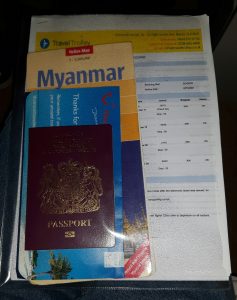 The journey from the Isle of Wight was fine, but my apprehension over having forgotten something critical remains – not assuaged by nearly leaving passport, money, ticket, visa, boarding passes etc. in the flat, or by completely forgetting to check the address I was coming to before I left!
The journey from the Isle of Wight was fine, but my apprehension over having forgotten something critical remains – not assuaged by nearly leaving passport, money, ticket, visa, boarding passes etc. in the flat, or by completely forgetting to check the address I was coming to before I left!
I wonder why, when I check in at precisely 24 hours before the flight as directed, almost all the seats on our giant plane appear to have been reserved, and we’re obliged to take separate seats a couple of rows apart.
I’m also always amazed at the amount of time it takes to get on a plane – the flight’s at 11.50 but I’ve set the alarm for 6.00am to ensure we get there in time! As my father used to say, air travel these days seems to carry the motto “Hurry up and wait”.
Still, look on the bright side, we’ll get there in the end, and the adventure will begin…
Thanaka, longyis and ngapi
As the time slowly approaches for my trip I tend to find more and more memories surfacing of things my mother, aunts and uncles told me about from Burma. I put a number of pictures into the gallery under the not-very-helpful title “Before leaving” (regularly updated – have a look!) but there are three words that have surfaced recently which are worth more explanation.
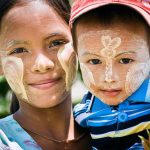 Thanaka is a combination sunscreen and cosmetic used widely in Burma, and I believe virtually nowhere else in the world. Usually applied to the face, especially the cheeks, thanaka is used by women and children, and – though to a lesser extent – men. Women in particular tend to make it very decorative with delicate patterns reminiscent of the use of henna in other cultures. It’s made, unsurprisingly, from the bark of the thanaka tree which is simply ground up to a powder with water and then kept as a paste. Here is a page full of photos of people wearing thanaka.
Thanaka is a combination sunscreen and cosmetic used widely in Burma, and I believe virtually nowhere else in the world. Usually applied to the face, especially the cheeks, thanaka is used by women and children, and – though to a lesser extent – men. Women in particular tend to make it very decorative with delicate patterns reminiscent of the use of henna in other cultures. It’s made, unsurprisingly, from the bark of the thanaka tree which is simply ground up to a powder with water and then kept as a paste. Here is a page full of photos of people wearing thanaka.
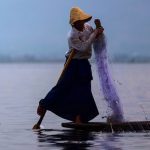 The Longyi is the ubiquitous loin-cloth (sometimes incorrectly referred to as a saree) which is worn by men, women and children. I remember my mother showing me how to tie it when I was a child. It’s a very simple and versatile garment – essentially just a tube you step in. If you want to swim, or do something energetic like climbing a tree, you hitch up the middle bit between your legs and tuck it into the waistband to make something like a pair of shorts. We always used to say this (or the middle-eastern equivalent) was the origin of the biblical phrase “to gird up one’s loins”. I’d really like to buy one or two when I go, although doubtless there’s nothing that brands you more as a tourist than wearing one as a westerner when you’re actually there! There’s even a Facebook page called Tourists wearing Longyis which is what I really don’t want to look like! Here are some pictures of what they should look like.
The Longyi is the ubiquitous loin-cloth (sometimes incorrectly referred to as a saree) which is worn by men, women and children. I remember my mother showing me how to tie it when I was a child. It’s a very simple and versatile garment – essentially just a tube you step in. If you want to swim, or do something energetic like climbing a tree, you hitch up the middle bit between your legs and tuck it into the waistband to make something like a pair of shorts. We always used to say this (or the middle-eastern equivalent) was the origin of the biblical phrase “to gird up one’s loins”. I’d really like to buy one or two when I go, although doubtless there’s nothing that brands you more as a tourist than wearing one as a westerner when you’re actually there! There’s even a Facebook page called Tourists wearing Longyis which is what I really don’t want to look like! Here are some pictures of what they should look like.
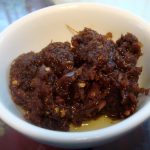 Ngapi is the Burmese version of the fermented prawn cooking sauce used throughout South-East Asia. However, ngapi is usually made with fish rather than prawns and has added chilli and salt to create a very pungent flavour. It’s instantly recognisable as a taste and indeed sometimes it’s eaten just as it is, not as a cooking ingredient. In the 1970s, when I visited my oldest aunt, Alice, who was closer in age to my grandmother than to my mother, she taught me some Burmese recipes which I still use today. Alice had a jar of ngapi which the had brought with her when she left Burma in the late 1940s and had kept going ever since! Sadly, when she moved to Winchester she threw it out, otherwise I would have gladly inherited it. Find out more
Ngapi is the Burmese version of the fermented prawn cooking sauce used throughout South-East Asia. However, ngapi is usually made with fish rather than prawns and has added chilli and salt to create a very pungent flavour. It’s instantly recognisable as a taste and indeed sometimes it’s eaten just as it is, not as a cooking ingredient. In the 1970s, when I visited my oldest aunt, Alice, who was closer in age to my grandmother than to my mother, she taught me some Burmese recipes which I still use today. Alice had a jar of ngapi which the had brought with her when she left Burma in the late 1940s and had kept going ever since! Sadly, when she moved to Winchester she threw it out, otherwise I would have gladly inherited it. Find out more
Photo Gallery Added
I’ve now finished adding a photo gallery to the website, and uploaded a number of test photos.
I’ll be able to organise them into days or locations etc., so there should be a new gallery page top accompany each blog/diary entry. More »
Burma/Myanmar
There’s a lot of renaming of place names these days, and Burma is no exception. I don’t like it anyway – for me, Mumbai will always be Bombay, Beijing will always be Peking and so on. I don’t understand the thinking behind it – the new names, just like the old ones, must be approximations, so who’s to say that one approximation is better than another?
In the case of Burma/Myanmar, however, it goes further. More »
6(ish) Months to Go…
It still seems a long way off, but somehow the very fact that we’ll be on our way to Burma in about 6 months’ time is already having an effect on me. The flights are booked and the deposits have been paid. Not much more to do yet-awhile, but I’m reading a number of books about Burma (thanks to the friends who have lent me theirs!) and of course thinking about it and planning it a lot. More »
